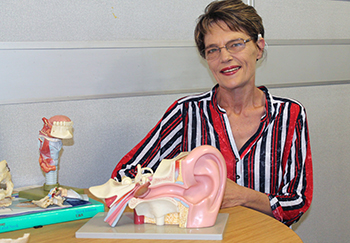
Dr Magteld Smith, researcher and deaf awareness
activist, from the Department of Otorhinolaryngology
at the UFS.
December is International Disability Awareness Month. Despite equality before the law and some improvements in societal attitudes, people with disabilities are still disadvantaged in many aspects of their lives. They are more likely to be the victims of crime, sexual abuse, are more likely to earn a low income or be unemployed, and less likely to gain qualifications than people without disabilities.
Demystifying disabilities is crucial
Dr Magteld Smith, a researcher at the University of the Free State (UFS) School of Medicine’s Department of Otorhinolaryngology, says that often people think the term “disability” only refers to people using a wheelchair, etc. However, this is a misperception because some individuals have visible disabilities, which can be seen, and some have invisible disabilities, which can’t be seen. Others have both visible and invisible disabilities. There is an ongoing debate as to which group has the greatest life struggles. Those with visible disabilities frequently have to explain what they can do, while individuals with invisible disabilities have to make clear what they cannot do.
Invisible disability is an umbrella term that captures a whole spectrum of invisible disabilities and the focus is not to maintain a list of specific conditions and diagnoses that are considered invisible disabilities. Invisible disabilities include debilitating fatigue, pain, cognitive dysfunctions, mental disorders, hearing and eyesight disabilities and conditions that are primarily neurological in nature.
Judging books by their covers
According to Dr Smith, research indicates that people living with invisible disabilities often suffer more strained relationships than those with visible disabilities due to a serious lack of knowledge, doubts and suspicion around their disability status.
Society might also make serious allegations that people with invisible disabilities are “faking it” or believe they are “lazy”, and sometimes think they are using their invisible disability as an “excuse” to receive “special treatment”, while the person has special needs to function.
Giving recognition and praise
“One of the most heartbreaking attitudes towards persons with invisible disabilities is that they very seldom enjoy acknowledgement for their efforts and accomplishments. The media also seldom report on the achievements of persons with invisible disabilities,” says Dr Smith.
Society has to understand that a person with a disability or disabilities is diagnosed by a medical professional involving various medical procedures and tests. It is not for a society to make any diagnosis of another person.
Dr Smith says the best place to start addressing misperceptions is for society to broaden its understanding of the vast, varying world of disabilities and be more sensitive about people with invisible disabilities. They should be acknowledged and given the same recognition as people with visible disabilities.